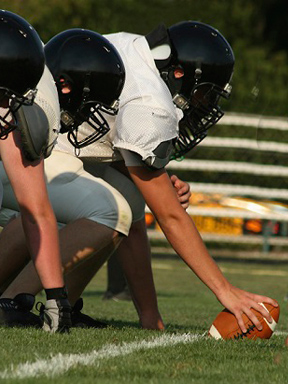 Did you know that more than 3.5 million US children under age 14 get hurt every year while playing sports?
Did you know that more than 3.5 million US children under age 14 get hurt every year while playing sports?
At the Sports Medicine Clinic at Children’s Nebraska, we see many young athletes who have sports injuries. And if you are a parent, coach, athletic trainer, or school administrator, we highly recommend becoming familiar with some of the most common types of injuries.
We treat a wide range of injuries, including concussions, musculoskeletal injuries (skeletal muscle, tendon, ligament, bone, joint, or nerve injuries), sprains and strains, overuse injuries, sports-related infections, heat illnesses, and sudden cardiac arrest.
Musculoskeletal Injuries
Any injury that occurs to a skeletal muscle, tendon, ligament, bone, joint, or nerve is a musculoskeletal injury. These are the most frequently seen sports injuries.
At the Children’s Sports Medicine Clinic, we specialize in diagnosing and treating a wide range of musculoskeletal injuries. The most common ones we treat are sprains, strains, and overuse injuries.
Sprains And Strains
A sprain is a stretching or tearing of ligaments — the tough bands of tissue that connect two bones together. These are found in and around joints. Sprains are common in the ankle, knee, and wrist.
A strain is a stretching or tearing of a muscle or tendon. A tendon is a fibrous cord of tissue that connects muscles to bones. Strains are common in the back or hamstring muscles.
Symptoms of both sprains and strains may include:
- Pain, swelling, or stiffness in the injured area
- Difficulty moving or using the body part
- Difficulty putting full weight on the injured extremity
- Warmth, bruising, or redness in the injured area
Sprains and strains are diagnosed by a physical examination that may involve X-rays. We have X-ray capability on site, eliminating the need for a separate visit to the radiology department.
Most sprains and strains heal quickly in adolescents and teens. Specific treatment will be determined based on:
- Your young athlete’s age, overall health, and medical history
- Extent of the injury
- Their tolerance for specific medications, procedures, or therapies
- Expectations for the course of the condition
- Sport or activity played
Overuse Injuries
An overuse injury is damage to a bone, muscle, ligament, or tendon caused by repetitive stress without allowing time for the body to heal. Shin splints, tendonitis, and stress fractures are examples of common overuse injuries. These typically develop over time. Young athletes often change their posture and how they move to compensate for the pain.
Overuse injuries are classified in these stages:
- Pain in the affected area after physical activity
- Pain in the affected area during the activity without restricting performance
- Pain in the affected area during the activity with restricted performance
- Chronic pain in the affected area that does not go away
Intervention is needed whenever pain is experienced during activity.
Our providers have the experience and expertise to make an accurate diagnosis and develop a treatment that will speed up the healing process so your young athlete can return to play. We take into account the following factors:
- Severity of the injury
- Sport, activity, position played
- Duration of the playing season
- Chance of re-injury or more significant injury
- Injury prevention strategies
Sports-Related Infections
There are a number of reasons why an athlete may develop an infection from playing sports, including skin-to-skin contact, sharing equipment and towels, or poor general hygiene.
Some of the most common conditions we see include:
-
Carbuncles
Carbuncles are clusters of boils (pimple-like bumps) usually found on the back of the neck or thigh. Adolescents and teens have an increased risk of carbuncles if they have poor overall health and hygiene, or have friction from their clothing. -
Cold sores
Cold sores are small blisters around the mouth that are caused by the herpes simplex virus. They are transmitted through skin-to-skin contact. -
Folliculitis
Folliculitis is the inflammation (swelling) of hair follicles due to an infection, injury, or irritation. It causes tender, swollen areas that form around hair follicles, often on the neck, breasts, buttocks, and face. -
Herpes gladiatorum
Herpes gladiatorum is a skin infection that is primarily seen among wrestlers. It is caused by herpes simplex virus type 1. Symptoms include clusters of fluid-filled blisters, swollen glands, and fever. -
Impetigo
Impetigo is a skin infection caused by bacteria breaking into the body, often through a scratch, cut, or bug bite. Symptoms typically include blisters and crusty spots on their face. -
Methicillin-resistant staphylococcus aureus (MRSA)
Methicillin-resistant staphylococcus aureus (MRSA) is a type of staph infection that does not get better with the type of antibiotics usually used to cure staph infections. This infection may occur because of breaks in the skin, or having skin-to-skin contact or sharing equipment with someone who is infected. -
Molluscum contagiosum
Molluscum contagiosum is an infection that causes small, raised, pink lesions or bumps with a dimple in the middle. The infection is caused by a virus that is easily spread with skin-to-skin contact. -
Ringworm (Tinea Corporis)
Ringworm (Tinea Corporis) is a skin infection caused by a fungus — there are no actual worms involved. It can be found on any part of the body. Athlete’s foot and jock itch are two well-known types of ringworm. -
Verruca
Verruca is another name for plantar warts — warts that are found on the feet. These warts develop from viruses that grow in warm, moist environments, such as a locker room or in a gym shoe.
If you see any sign of infection on your young athlete’s skin, notify their school’s athletic trainer and schedule an appointment with a physician. Rapid treatment can decrease severity and spread of the infection.

Athletes can help prevent infections by not sharing personal items, such as water bottles, towels, razors, or unwashed uniforms and equipment. Remember to wash footwear, uniforms, and equipment regularly. Also disinfect grooming tools, follow good hand hygiene, cover open wounds, and do skin checks. And keep up to date on recommended immunizations.
Infection Resources
- Sports Related Skin Infections Position Statement and Guidelines – April 2016 (National Federation of High Schools – NFHS)
- American Academy of Pediatrics (AAP) Committee on Infection Diseases, AAP Council on Sports Medicine and Fitness. Infections Diseases Associated with Organized Sports and Outbreak Control. Pediatrics. 2017;140(4):e20172477
- Protect Yourself: How to Avoid Common Skin Conditions in Sports – National Athletic Trainers’ Association